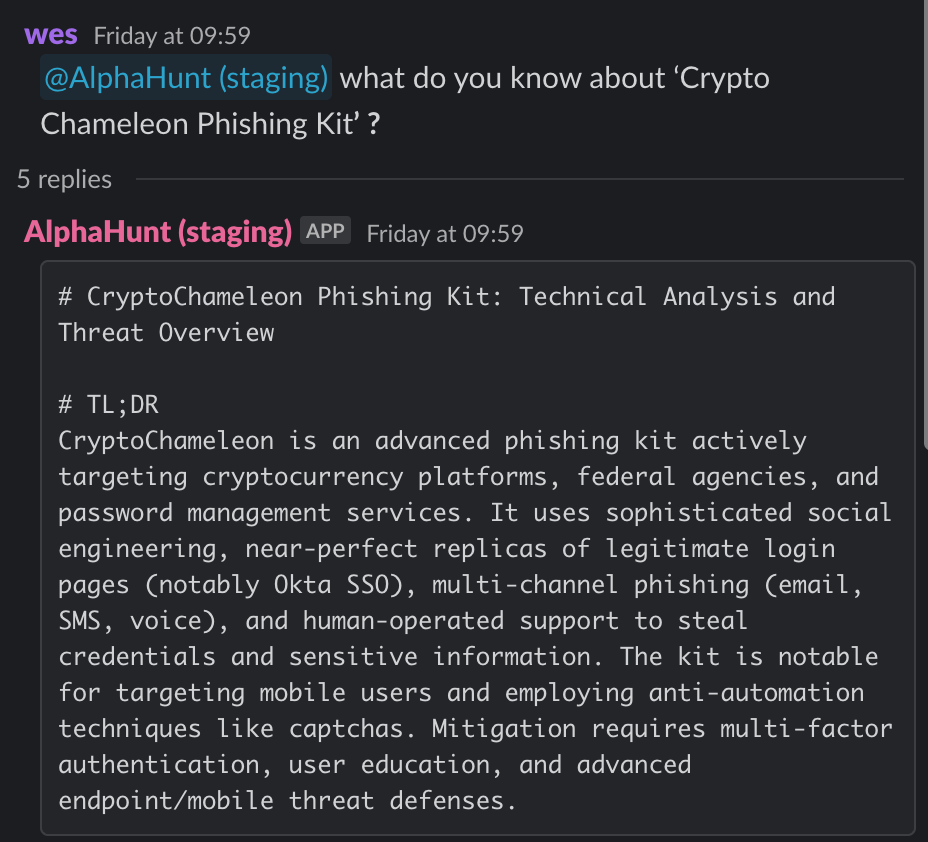CryptoChameleon: Multi-Channel Phishing Kit Driving Advanced Credential Theft in Financial and Crypto Sectors
CryptoChameleon is an advanced phishing kit distributed via phishing-as-a-service platforms, enabling rapid, scalable attacks against cryptocurrency users, financial institutions, and related sectors...


(Have feedback? Did something resonate with you? Did something annoy you? Just hit reply! :))
Get questions from your boss, like this:
- what do you know about ‘Crypto Chameleon Phishing Kit’ ?
Are you ready to level up your skillset? Get Started Here!
TL;DR
Key Points
-
- CryptoChameleon is a sophisticated phishing kit enabling multi-channel attacks (email, SMS, vishing) with advanced MFA bypass (TOTP theft), primarily targeting cryptocurrency users and financial institutions.
- Security teams must monitor for domains registered on NiceNIC, Cloudflare Turnstile anti-bot evasion, and spearphishing campaigns leveraging CRM/bulk email provider compromise.
-
- The kit is part of The Comm cybercrime ecosystem, sharing infrastructure and TTPs with groups like Scattered Spider and campaigns such as PoisonSeed.
- Attribution can be refined by analyzing domain registration patterns, WHOIS metadata, and hosting provider usage.
-
- Recent campaigns exploit supply chain vectors, leveraging compromised CRM and bulk email accounts to distribute phishing at scale.
- Organizations should collaborate with CRM vendors and threat intelligence communities for rapid IoC sharing and takedown coordination.
-
- Defenders are advised to deploy phishing-resistant MFA (hardware tokens), enhance anti-phishing detection (including anti-bot evasion), and conduct targeted user awareness training on multi-channel threats.
- KPIs include reducing phishing domain detection time, increasing detection rates, and lowering user click-through rates on phishing links.
-
- The threat landscape is evolving toward modular phishing platforms, AI-driven social engineering, and increased targeting of emerging digital economies and payment platforms.
- Ongoing monitoring of infrastructure, user behavior, and regulatory trends is critical for proactive defense.
Executive Summary
CryptoChameleon is an advanced phishing kit distributed via phishing-as-a-service platforms, enabling rapid, scalable attacks against cryptocurrency users, financial institutions, and related sectors. It features multi-channel delivery (email, SMS, vishing), sophisticated MFA bypass via TOTP theft, and anti-detection mechanisms such as Cloudflare Turnstile evasion. The kit is linked to The Comm cybercrime community, including groups like Scattered Spider, and shares infrastructure and TTPs with campaigns like PoisonSeed.
Recent campaigns have shifted toward supply chain phishing, exploiting compromised CRM and bulk email providers to distribute phishing at scale, complicating detection and mitigation. The kit’s infrastructure is characterized by domains registered on NiceNIC, hosting on Cloudflare, Njalla, and DigitalOcean, and distinctive WHOIS metadata.
MITRE ATT&CK mapping highlights spearphishing (T1566), MFA bypass (T1556), credential access (T1078), and infrastructure compromise (T1586) as core techniques. No direct links to other malware families were found, but operational similarities exist with kits delivering RATs and info-stealers.
Actionable recommendations include advanced domain and infrastructure monitoring, rapid takedown of phishing domains, deployment of phishing-resistant MFA, user training on multi-channel threats, and collaboration with threat intelligence communities. The forecast anticipates further evolution toward modular, AI-driven phishing platforms, expanded targeting of digital economies, and increased regulatory pressure for supply chain and authentication security.
Security practitioners should prioritize detection of multi-channel phishing, MFA bypass attempts, and supply chain compromise, while tracking infrastructure patterns and collaborating across the ecosystem to disrupt CryptoChameleon and related campaigns.
Research
Origin
The CryptoChameleon Phishing Kit is a sophisticated toolkit primarily targeting cryptocurrency users and financial institutions. It is part of a broader cybercrime ecosystem known as The Comm, which includes threat actor groups such as CryptoChameleon and Scattered Spider. The kit provides ready-made phishing page templates, multi-channel attack capabilities (email, SMS, vishing), and advanced features like multi-factor authentication bypass through TOTP theft. It is often distributed via phishing-as-a-service platforms, enabling rapid deployment and scaling of campaigns.
Motivation
The primary motivation behind CryptoChameleon is financial gain through credential theft, particularly targeting cryptocurrency wallets and financial accounts. The kit facilitates large-scale credential harvesting, enabling attackers to hijack accounts, transfer funds, and monetize stolen credentials via fraudulent transactions and mobile wallet abuse.
Historical Context
CryptoChameleon operates within a cybercrime community known as The Comm, which has been active since at least 2022. The kit and associated threat actors have evolved to include multi-channel phishing, anti-detection mechanisms such as Cloudflare Turnstile bot detection evasion, and sophisticated credential harvesting workflows. The kit is linked to campaigns targeting high-value cryptocurrency brands like Coinbase and Ledger, as well as bulk email and CRM providers, indicating a supply chain phishing approach.
Timeline
- 2022: Initial use of domains linked to CryptoChameleon in phishing campaigns.
- 2023-2024: Expansion of phishing kits and campaigns targeting cryptocurrency and financial sectors.
- 2024-2025: Use of Cloudflare Turnstile anti-bot technology and multi-channel phishing vectors.
- Early 2025: Observed campaigns involving supply chain spam operations targeting CRM and bulk email providers.
- 2025: Arrests related to tap-to-pay fraud schemes leveraging credentials harvested via phishing kits.
Countries Targeted
- United States – Major target due to large financial and crypto user base.
- Canada – Targeted for financial institutions and payment card fraud.
- Australia – Targeted in phishing campaigns against financial institutions.
- Latin America – Increasingly targeted in mobile phishing campaigns.
- Asia-Pacific – Broad targeting including banks and payment services.
Sectors Targeted
- Financial Institutions – Banks, credit unions, and payment processors targeted for credential theft and fraud.
- Cryptocurrency Users – Targeted for wallet seed phrases and account credentials.
- Telecommunications – Targeted for SMS and mobile messaging phishing.
- Retail – Targeted via payment card fraud and mobile wallet abuse.
- Public Sector – Some campaigns spoof government and intelligence agency websites for information gathering.
Links to Other Malware
No direct links to other malware families were found specifically for CryptoChameleon, but it shares operational similarities with other phishing kits that deliver remote access trojans (RATs) and information stealers such as BitRAT and Lumma Stealer.
Similar Malware
CryptoChameleon shares characteristics with other multi-channel phishing kits used in campaigns like PoisonSeed and those operated by groups such as the Smishing Triad. These kits also employ multi-factor authentication bypass techniques, use bot detection evasion, and target financial and cryptocurrency sectors.
Threat Actors
CryptoChameleon is part of The Comm, a cybercrime community that includes groups like Scattered Spider. While PoisonSeed is a distinct campaign, it shares infrastructure and targeting overlaps with CryptoChameleon, particularly in targeting cryptocurrency brands and bulk email providers. Attribution to specific actors is supported by infrastructure patterns such as domain registration on NiceNIC, use of obscene language in WHOIS fields, and hosting on Cloudflare and other providers. The Comm actors are known for using phishing-as-a-service platforms and sophisticated social engineering tactics.
Breaches Involving This Malware
No specific public breach disclosures directly naming CryptoChameleon were found. However, the kit is implicated in ongoing phishing campaigns that have led to credential theft and financial fraud, including tap-to-pay fraud arrests in the United States.
Recommendations, Actions, Suggested Pivots, Forecasts and Next Steps..
(Subscribers Only)



![[DEEP RESEARCH] Token Factory: The 5 Costliest US Breaches of 2025](/content/images/size/w600/2026/01/z.png)

